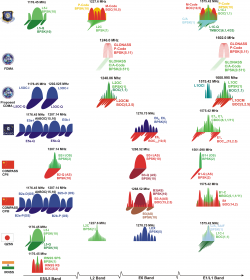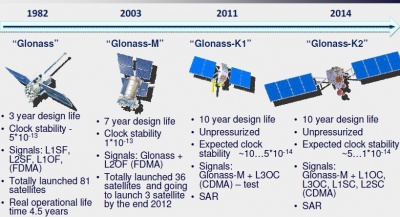If you wish to contribute or participate in the discussions about articles you are invited to contact the Editor
GLONASS Future and Evolutions
| GLONASS | |
|---|---|
| Title | GLONASS Future and Evolutions |
| Author(s) | GMV |
| Level | Basic |
| Year of Publication | 2011 |
In 2001, there were only seven GLONASS operational satellites in orbit. Acknowledging that navigation satellite system GLONASS was a top priority, the Government of the Russian Federation, by its Decree No. 587 of 20 August 2001, approved a Federal Task Program on the Global Navigation System (GNS) [1]. The GNS Program covers improvement of space, ground-based and user equipment segments of the GLONASS system.
One of the main objectives of the Program is to ensure GLONASS performance similar to GPS by the end of 2011. GLONASS poorer performance is the culmination of several factors:[2]
- poorer on-board atomic clocks
- less stability and predictability in the satellite orbits (and therefore less accuracy in GLONASS broadcast ephemerides)
- fewer satellites providing signals
- operational control and ground monitoring segment limited to Russian territory,
The Program is scheduled to end in 2011, however the Federal Spacy Agency has already announced that the maintenance and development of GLONASS will be extended until 2020, and will cost 402 billion rubles ($14.35 billion).[3]
Signal Modernization
Traditionally, GLONASS satellites transmits navigational radiosignals on two frequency sub-bands (L1 ~ 1602 MHz and L2 ~ 1246 MHz), relying on the Frequency Division Multiple Access (FDMA) technique in contrast to CDMA employed by all the other GNSS systems.
Aiming to provide better accuracy, multipath resistance and especially, greater interoperability with GPS and future GALILEO and other GNSS Systems, new GLONASS-K satellites will transmit CDMA signals in addition to the system’s traditional FDMA. In fact, since the successful launch of the first GLONASS K1 satellite, [4], a new L3 CDMA signal is already being transmitting and tracked by several receiver companies. The GLONASS L3 signal is centered at 1207.14 MHz, the same frequency as Galileo/COMPASS signal E5b, in the region allocated to the Aeronautical Radio 1 Navigation Service (ARNS). These bands are especially suitable for Safety-of-Life applications because no other users are allowed to interfere with their signals.
The future GLONASS K2 satellites to be launched in 2013, will feature three additional CDMA signals near the original FDMA frequencies, one obfuscated signal located at 1242 MHz in the L2 band, as well as two signals at 1575.42 MHz in the L1 band.
A modernized GLONASS-K satellite, GLONASS-KM, for launch after 2015 [5] may also transmit on the GPS L5 frequency at 1176.45 MHz, the same as the modernized GPS signal "Safety of Life" (L5) and Galileo signal E5a.
Space Segment
GLONASS Space Segment modernization, began with the second generation of satellites, GLONASS-M. These satellites use previously reserved bytes in the navigation message to provide additional information, including the divergence of GPS and GLONASS time scales, navigation frame authenticity (validity) flags, and age of data information.[6] Moreover, improved filters were installed to reduce out-of-band emissions and on-board clock stability over 24 hours was improved from 5x10-13 to 1x10-13.
The first satellite of the third generation, GLONASS-K1, was launched on February 26 2011. GLONASS-K1 satellites have a 10-year design life and carry a CDMA civil signal at L3 frequency in the 1205 MHz band.
A completely new design, GLONASS-K2, will start launching in 2013. GLONASS-K2 satellites will have a 10-year design life and a clock stability of 1x10-14. Besides the CDMA signals on L3, CDMA signals will also be transmitted on L1 and L2. The GLONASS-K satellites will transmit the legacy FDMA satellites in addition to the CDMA signals.
A modernized GLONASS-K satellite, GLONASS-KM, for launch after 2015 is now under study. In addition to transmitting legacy FDMA signals on L1 and L2 and CDMA signals on L1, L2, and L3, CDMA signals may also be transmitted on the GPS L5 frequency at 1176.45 MHz.Plans for GLONASS-K include providing GNSS integrity information in the third civil signal and global differential ephemeris and time corrections. [6] Also being studied is an alternative to the present three-plane, equally spaced satellite constellation. This new constellation design would require that the legacy FDMA signals be switched off.[5]
Ground Segment
In order to provide performance comparable with GPS, GLONAS modernization plan includes the addition of sixteen reference stations in the GLONASS ground monitoring segment,[7] nine sites in Russian territory and six outside the country. In fact, GLONASS has already established its first monitoring station outside Russia, in Antarctica.[8]
Also, the developments of both the GLONASS tracking capabilities as well as the steady increase in the number of GLONASS satellites, has had a positive influence on the accuracy of the GLONASS orbits and clocks. For instance, according to the GPSWorld article “Innovation: GPS, GLONASS, and More”[9] in 2008, the orbit quality, was at the 120-millimeter level (cross-track), which was improved significantly to the 85-millimeter level by the end of 2009.
Aiming to improve the interoperability with other GNSS systems, GLONASS coordinate system has been tied to the International Terrestrial Reference System (ITR), an international standard. The ephemeris information implementing the PZ-90.02 reference system was updated on all operational GLONASS satellites from 12:00 to 17:00 UTC, September 20th., 2007. From this time on, the satellites are broadcasting in the PZ-90.02. This ECEF reference frame is an updated version of PZ-90, closest to the ITRF2000.
User Segment
Although the GLONASS constellation is nearing global coverage, its commercialization, especially development of the user segment, has been lacking compared to the U.S. GPS system.[10]
To improve the situation, the Russian government has been actively promoting GLONASS for civilian use. According to Russian Federal Space Agency,[11] GLONASS will be installed in all new cars starting in 2013 and in 2015, the market volume of GLONASS on transport alone will grow by 16 times to 120 billion rubles ($4.3 billion), compared with 7.5 billion rubles in 2010.
In February, the government announced that all passenger cars, large transport vehicles and vehicles transporting dangerous materials will be required to use GLONASS-equipped navigators as of July 2011.[12] The tracking of this road traffic will be tied to road tax collection as well as to a roadside assistance in the event of an accident. The tracking system, known as ERA, will begin testing in July 2011, with transponders becoming mandatory in all vehicles by 2014.[13]
Notes
References
- ^ Federal Task Program on the Global Navigation System
- ^ Russia Dwells on Glonass Future, InsideGNSS
- ^ GLONASS, Galileo Finances Star at Paris Air Show, InsideGNSS
- ^ Russia’s First GLONASS-K In Orbit, CDMA Signals Coming, insideGNSS
- ^ a b GLONASS Update Delves into Constellation Details, GPSworld
- ^ a b GLONASS: The Once and Future GNSS, InsideGNSS
- ^ Russian Company Offers 'Preliminary' Specifications for GLONASS CDMA Signal, InsideGNSS
- ^ GLONASS Up to Date and Out of State, GPSWorld
- ^ Innovation: GPS, GLONASS, and More, GPSWorld
- ^ GLONASS on Wikipedia
- ^ Russian Federal Space Agency, GLONASS news
- ^ Ministry of transport want to fine for absence of GLONASS navigators
- ^ Russia accelerates GLONASS Navigation Satellite launches


